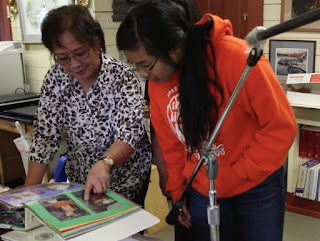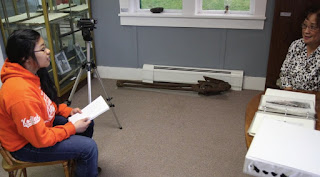 |
| Marina grew her digital literacy skills after the film workshop through a Public Radio internship |
This is a guest post from a former student, Marina Cummiskey. I first met her when she had just finished 6th grade, and she blew me out of the water with her journalistic prowess. She is now done with high school and has been traveling the world and documenting it on her own blog that you can peruse here. I am grateful to have her amazing voice on this blog!
_______________________________
 |
| Marina interviews Senator Mark Begich |
Before the class began, Marie asked all of us to rank film topics based on what we were most interested in. Somehow I ended up with my last ranked topic (the J-1 Visa controversy) but, as it turns out, that was definitely the best fit for me, due to my direct connection with the theme. A few years prior to the workshop, my family hosted a Turkish J-1 visa worker when he showed up in Kodiak to work in the canneries. I ended up reconnecting with him over Skype to interview him for my film, as well a cannery manager and Senator Mark Begich.
 |
| Marina holds ash on Kodiak from the 1912 Katmai Eruption |
To my surprise, after I had material from my interviews and other background footage, the script for my film flowed naturally and was fun and easy to stitch together. After the workshop ended I continued along the same path, and ended up volunteering at the Baranov Museum and creating another film, this time on the 1912 Katmai Eruption. This in turn lead to the start of two years of volunteering as well as a summer internship at Kodiak’s local public radio station, KMXT. The workshop only opened up more opportunities for me, and I’m considering studying a form of film or journalism in college.
I encourage other students
not to be intimidated by the work required or the skills necessary to make these films; as you engage with your topic and make connections around you the process only becomes more and more interesting and exciting! This program helps youth connect with Kodiak and our history, as well as start the process of becoming active members in community, country, and the world. It’s so important for young people to develop an opinion of their own and engage in the issues and debates that are a part of life for everyone. If you live in this world, you need to be a part of it too.
Marina's film on the J-1 visa controversy













